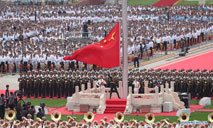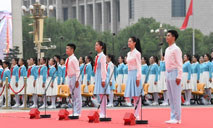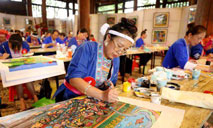China's Shenzhou-12 manned space mission a "milestone" in technological development -- LatAm experts
MEXICO CITY, June 25 (Xinhua) -- Experts hailed the successful launch of China's Shenzhou-12 manned space mission as a "milestone" that cements the Asian country's technological development.
"The ability to mount a space station, coupled with the Chang'e-5 lunar probe or the Mars rover Zhurong, increasingly demonstrates China's state-of-the-art space technological capabilities, whose achievements the world is celebrating," said Argentine aeronautical engineer Pablo Hollar.
In less than a decade, China has advanced by leaps and bounds in technology, to the extent that its astronauts even enjoy greater creature comforts in space, said Hollar, who serves as a manager of Access to Space, a division of VENG, an Argentine technology and services company specialized in the space industry.
"The fact that astronauts can rely on an area three times larger than Tiangong-2, more than 100 meals to choose from, the availability to communicate by video and email, or a life support system to ensure the long-term permanence of humans, shows that China is thinking about long-term technological developments, with people living there for a long time," Hollar noted.
The Shenzhou-12 manned spacecraft was launched last week on a Long March 2F carrier rocket from the Jiuquan Satellite Launch Center in northwest China.
This is China's seventh manned mission to space and the first during the construction of the space station, according to the China Manned Space Agency.
It is also the first in nearly five years since China's last manned mission.
Alejandro Farah Simon, a specialist in satellite space technology at the National Autonomous University of Mexico (UNAM), said China's space program "has achieved a milestone in its history," and also took a step forward for humankind as a whole.
"This mission contributes to humanity by directing our eyes towards space and succeeding in placing a space module hundreds of kilometers high. They succeeded and the technological spillover of everything they do will be reflected in other applications here on Earth over the coming years," said Simon.
The mission also shows that through cooperation in technological development, countries can strengthen ties and work in harmony, he said.
"I believe that the most important thing is the scientific and technological collaboration that is taking place, and it should be emphasized that it will have a social impact for the benefit of our planet," added Simon, who is also a member of UNAM's University Space Program.
Space physics expert Jose Francisco Valdes Galicia also said the mission will have a lasting impact for future generations.
"China has shown the world that it is possible to develop your own technology, (and) that it is not exclusive to just a few countries. I believe that if you have the will, it is possible to make space projects come true," Valdes said.
"It is admirable how they have managed to develop such sophisticated technology in such a short time, and something like a space station requires a lot of talent and ingenuity, as well as the government's determination to support it with financial resources," said Valdes, who coordinates the University Space Program at UNAM.
The space mission became a talking point on social media.
"I think it was a matter of time before the Asian country made this great leap into space exploration. China's technological growth in the last 20 years has put it at the forefront," Oswaldo Vega Martinez posted to Facebook.
Another user, Juan Carlos Soto Gonzalez, noted the Asian country "is at the forefront in science and technology, aspiring to continue working and growing in the area of aerospace science."
"An important and intelligent decision to have accurate investigation of experiments in space, which surely in a short time will be more important and necessary for humanity," added Soto, who works as an industrial engineer.
The mission of the Shenzhou-12 manned spaceflight will help test technologies including long-term astronaut stays, recycling and life support systems, as well as in-orbit maintenance.
Photos
Related Stories
Copyright © 2021 People's Daily Online. All Rights Reserved.










